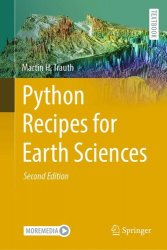Python Recipes for Earth Sciences, Second Edition
- Добавил: literator
- Дата: 8-10-2024, 14:29
- Комментариев: 0
 Название: Python Recipes for Earth Sciences, Second Edition
Название: Python Recipes for Earth Sciences, Second EditionАвтор: Martin H. Trauth
Издательство: Springer
Год: 2024
Страниц: 500
Язык: английский
Формат: pdf (true)
Размер: 20.1 MB
Python is used in a wide range of geoscientific applications, such as in processing images for remote sensing, in generating and processing digital elevation models, and in analyzing time series. This book introduces methods of data analysis in the geosciences using Python that include basic statistics for univariate, bivariate, and multivariate data sets, time series analysis, and signal processing; the analysis of spatial and directional data; and image analysis. The text includes numerous examples that demonstrate how Python can be used on data sets from the earth sciences. Codes are available online through GitHub.
- Introduces methods of data analysis in geosciences using Python
- Contains a complete collection of computer codes and sample data, as well as an accompanying blog
- Written by an expert for geoscientific modeling programs
The book Python Recipes for Earth Sciences is designed to help undergraduate and postgraduate students, doctoral students, post-doctoral researchers, and professionals alike in finding quick solutions to common data analysis problems in the earth sciences. It provides a minimal amount of theoretical background and demonstrates the application of all described methods via examples.
The present book contains Python scripts that can be used to solve typical problems in the earth sciences via simple statistics, time series analysis, geostatistics, and image processing. It also demonstrates the application of selected advanced techniques of data analysis, such as nonlinear time series analysis, adaptive filtering, bootstrapping, and terrain analysis. The supplementary electronic material (available online through Springer Link) includes the example data and the Python commands featured in the book. The Python codes can be easily modified for use with the reader’s own data and projects.
The Python software–which has been around for more than 30 years–is used since it not only provides numerous ready-to-use algorithms for most methods of data analysis, but also allows the existing routines to be modified and expanded and additionally enables new software to be developed. However, most methods are introduced with very simple codes before any Python-specific functions are used. As a result, users of alternatives to Python will also find value in this book.
In order to derive the maximum benefit from this book, the reader will need to have access to the Python software and be able to execute the recipes while reading the book. The Python recipes yield various graphs on the screen that are not shown in the printed book. The tutorial-style book does, however, contain numerous figures, thereby making it possible to go through the text without actually running Python on a computer. I developed the recipes using Python 3.8.8, though most recipes will also work with earlier software releases, but not with Python 2. While undergraduates participating in a course on data analysis might wish to go through the entire book, more experienced readers may choose to refer to only one particular method in order to solve a specific problem.
When using this book, it is important to keep in mind that it is based on a book that uses MATLAB for data analysis in the earth sciences. An attempt has been made to remain as close as possible to the original didactic concept and text of the MATLAB book, even if it may seem unusual or awkward for some Python users. On the other hand, this didactic concept will be familiar to the many users who, for whatever reason, have made switch from MATLAB to Python. These users, like me, are familiar with MATLAB and first look for similar solutions in Python instead of programming Python code from scratch. This happens very often and is reflected in many Python packages, such as NumPy and Matplotlib, which are highly similar to MATLAB toolboxes, right down to their identical function names and input arguments.
Скачать Python Recipes for Earth Sciences, Second Edition
Внимание
Уважаемый посетитель, Вы зашли на сайт как незарегистрированный пользователь.
Мы рекомендуем Вам зарегистрироваться либо войти на сайт под своим именем.
Уважаемый посетитель, Вы зашли на сайт как незарегистрированный пользователь.
Мы рекомендуем Вам зарегистрироваться либо войти на сайт под своим именем.
Информация
Посетители, находящиеся в группе Гости, не могут оставлять комментарии к данной публикации.
Посетители, находящиеся в группе Гости, не могут оставлять комментарии к данной публикации.
